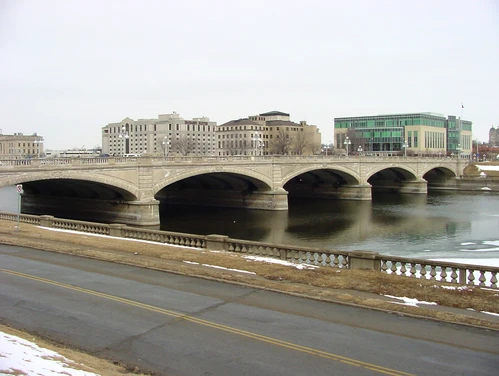- Year constructed: 1918
- Alternate name: Des Moines River Bridge
- Bridge type: Concrete Filled Spandrel Arch
- National Register of Historic Places status: Listed
- Length: 496 feet
- Width: 66 feet
- Spans: 5
- FHWA: 3690
- Jurisdiction: City of Des Moines
- Location: Court Avenue over the Des Moines River in Des Moines, Section 4, T78N-R24W (Des Moines Township)
Details
This outstanding multiple-span concrete arch bridge carries Court Avenue over the Des Moines River in northern Des Moines. The concrete-filled spandrel arch dates to 1916. Located in the heart of Iowa's capital city, the Court Avenue crossing was a pivotal one, and the current bridge was preceded by a series of earlier spans, beginning in 1856-57. The crossing's early history was punctuated with structural failures, but eventually, the Des Moines City Council concluded that a new permanent structure was needed to accommodate the city's growing citizenry and heavier vehicular traffic.
Even before ground was broken for the new foundations, an interesting dilemma developed surrounding the bridge's design. The conflict, as reported by The Des Moines Daily Tribune, involved whether a design produced by Des Moines engineer James B. Marsh should be used instead of plans generated in the county engineering department. In defense of his decision, Mayor MacVicar unknowingly caught himself up in an uncomfortable situation. Both sets of plans were submitted for the new Court Avenue Bridge as well as the Grand Avenue Bridge, erected a few months earlier. The county engineer's plans were selected for Grand Avenue whereas Marsh plans were chosen for the Court Avenue crossing. MacVicar, after selecting Marsh as the designer for the Court Avenue project, claimed the Marsh plans were superior "as regards beauty, harmony with its surroundings, cost of construction and strength" to the county's specifications. In addition, the Marsh plans were supposedly more economical overall, even with the extra architectural fees. Herein, reporters claimed, laid the problem. If the Marsh bridge plan was both visually and financially preferable, why did the council agree to use county plans for the Grand Avenue structure? MacVicar stood steadfastly by his decision; the bridge was erected by the Des Moines-based Koss Construction Company in 1918 without further delays.
The 496-foot Court Avenue Bridge was formally opened to the public on July 10, 1918, with thousands of people in attendance. Now over seventy-five years old, the bridge has continued to ride its tidal wave of success. The arch has retained a high degree of structural integrity, with no major alterations of note. A 1981 reconstruction only involved minor maintenance-related repairs. Over time, the original impact of the bridge has not been altered in any way, securing its significance as both a major river crossing and as a Des Moines transportation and architectural-related resource.
Adapted from Crow-Dolby and Fraser 1993
Areas Served
- Polk
